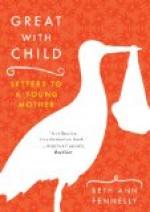But while I contend for their use as consistent with health and sound philosophy, I must not be understood as admitting the use of such hats as are worn at present, even by children. They are, as I have said before, too hot. What should be substituted, I am unable to determine; but until something can be supplied, which would not be half so oppressive as our common wool hats, I should regard it as the lesser evil to omit them entirely. The danger of going bare-headed, if the practice is commenced early, we know from the customs of some savage nations, can never be very great.
SEC. 7. Covering for the Feet.
The same reason for avoiding the use of any covering for the head, in early infancy, is a sufficient reason for covering the feet well. For just in proportion as the blood is sent to the head in superabundance, and keeps up in it an undue degree of heat, just in the same proportion is it sent to the feet in too small a quantity, leaving these parts liable to cold. Now it is a fundamental law with medical men, that the feet ought to be kept warmer than the head, if possible; especially while the child is very young, and exposed to brain diseases.
So long, therefore, as children are young, and unable to exercise their feet, stockings ought to be used, both in summer and winter; but I prefer to have them short, unless long ones can be used without garters. Everything in the shape of a garter or ligature round the limbs, body, or neck of a child, except a single body-band, already mentioned in another chapter, ought forever to be banished.
It has often been objected, I know, that stockings will make the feet tender. But as no child was ever hardened by continued and severe cold applied to any part of the body, but the contrary, so no one was ever made more tender by being kept moderately warm. Excess of heat, like excess of cold, will alike weaken either children or adults; but there is little danger of heating the feet and legs of infants too much during the first year of infancy.
It is also said that stockings are apt to receive and retain wet. But as I shall show in another place that wet clothes should be frequently changed, this objection would be equally strong against wearing coats and diapers.
As to shoes, there is some variety of opinion among medical men. A few hold that they cramp the feet, and prevent children from learning to walk as early as they otherwise would. If it were best for children that they should learn to walk as early as possible, the last objection might have weight. But it seems to me not at all desirable to be in haste about their walking. Indeed, I greatly prefer to retard their progress, in this respect, rather than to hasten it.
As to the first objection, that shoes cramp the feet too much, nearly its whole force turns upon the question whether they are made of proper materials or not. There is no need of making them of cow-hide, or any other thick leather. The soles are the most important part. These will defend the feet against pins, needles, and such other sharp substances as are usually found on the floor; and the upper part of the shoe, so long as the wearer remains in the nursery, may be made of the softest and most yielding material—even of cloth. Infants’ shoes should always be made on two lasts, one for each foot.




